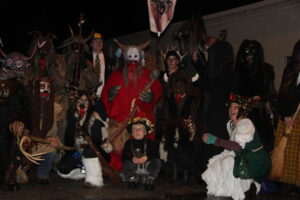As winter descends upon the Alpine regions, a unique and exhilarating celebration unfolds, blending ancient folklore with vibrant festivities. Krampusnacht, or Krampus Night, is a captivating event steeped in tradition and mischief that takes place on December 5th each year. It is a night where the fearsome figure of Krampus—an ominous, goat-like creature with horns, fangs, and cloven hooves—takes center stage alongside the benevolent Saint Nicholas. This intriguing festival provides a dramatic contrast between the nurturing rewards of Saint Nicholas and the playful scaring tactics of Krampus, creating a memorable experience that is both thrilling and thought-provoking.
(commons.wikipedia)
Origins and Evolution
The Festival Experience
Cultural Significance
Krampusnacht holds profound cultural significance in the Alpine regions, where it is much more than just a night of frights and revelry. The festival provides a means for communities to connect with their heritage and preserve ancient traditions that have been passed down through generations. This celebration is deeply rooted in the local folklore and history, reflecting the unique cultural identity of the Alpine communities. By participating in Krampusnacht, people honor their ancestors and maintain a tangible link to the past, ensuring that traditional customs are not lost over time.
In addition to its cultural importance, Krampusnacht serves as a major social event, fostering a sense of unity and community spirit. The festival brings together residents and visitors alike, creating an inclusive environment where people can engage in shared celebrations and experiences. This communal aspect of Krampusnacht strengthens social bonds and reinforces local traditions, making it a significant event for both personal and collective identity within the Alpine regions.
(Global Interest and Adaptation)
In recent years, Krampusnacht has garnered international attention, expanding beyond its traditional Alpine heartlands to become a global phenomenon. Festivals and events inspired by Krampusnacht are now held in various countries around the world, introducing the tradition to new audiences and contexts. This global interest has played a crucial role in preserving and promoting the festival, ensuring that it continues to thrive and evolve.
The international expansion of Krampusnacht has led to diverse adaptations and interpretations of the festival. While maintaining core elements of the tradition, such as elaborate costumes and lively parades, new regions have added their own unique twists to the celebration. This adaptability has helped Krampusnacht remain relevant and engaging in a variety of cultural settings, demonstrating its enduring appeal and the capacity for cultural exchange. The continued global fascination with Krampusnacht not only enriches the festival but also highlights the universal themes of folklore and communal celebration that resonate across different cultures.
Preservation and Modern Adaptations
Conclusion,
Krampusnacht stands as a striking example of how ancient traditions can seamlessly blend with modern celebrations, creating a festival that is as rich in history as it is in excitement. This unique event captures the essence of Alpine folklore through its dramatic portrayal of Krampus and the contrasting benevolence of Saint Nicholas. The festival’s lively “Krampuslauf” brings together communities in a spirited display of costumes and revelry, while also highlighting the moral themes of reward and punishment that have been central to its history.
As Krampusnacht continues to gain global recognition, it preserves its cultural roots while adapting to contemporary contexts. The festival’s ability to maintain its traditional authenticity while embracing new forms of media and engagement ensures that it remains relevant and captivating. Whether through its exhilarating parades or its evocative folklore, Krampusnacht offers a compelling blend of festivity and cultural heritage, captivating the imaginations of all who partake in its unique and thrilling celebrations.




